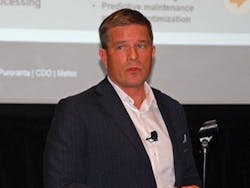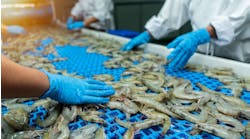“Customers are asking for mining solutions that are more efficient, smaller and smarter.” Metso’s Jani Puroranta was among the industry experts forecasting a digital future for the mining industry.
Most mining operations happen underground, of course, but even there, deep in the Earth's crust, they can't escape the waves of digitalizing technologies reshaping industry. A diverse crew of six experts detailed how digitalization and other forces are affecting mining worldwide during the Mining Industry Forum during Automation Fair 2018 this week in Philadelphia.
To lead off the forum, Sujeet Chand, CTO, Rockwell Automation, recommended that mining and other industries would benefit from turning the usual digitalization model on its head.
"Connectivity and digitalization usually means bringing in lots of big data, analyzing it to look for trends, and trying improve business outcomes," said Chand. "I'm going to be provocative, and say that digitalization shouldn't start with data. This process needs to be flipped, and instead start by looking at business outcomes that need analytical assistance, data and connectivity to achieve. This is a great time to be in mining because we're at an inflection point where there are all kinds of computing and communications technologies emerging that can help."
Chand shared that the World Economic Forum's 2017 report, "Digital Transformation Initiative: Mining and Metals," estimated digitalization will be worth $430-780 billion to the mining industries during 2017-25. Digitalization will increase uptime for 47% of mining respondents, improve productivity for 42%, and improve decision making for 40%. He added that early investments in digitalization are already paying off for firms like BHP Billiton, which recently reported a 20x improvement in production data accessibility.
"The focus of digitalization has to be on business value first," said Chand. "Big data will be replaced by structured and contextualized data that drives analytics to match business values. By eliminating former information silos, connected mines will have this contextualized data from reliable sources, use it for real-time analysis, and achieve rapid business value. Some of this will happen in the cloud, but more local computing and analytics will be available to address latency and security issues."
Intelligent minerals processing
Jani Puroranta, chief digital officer for mining equipment-maker Metso, sees digitalization affecting his business in two primary ways: increasingly autonomous vehicles and equipment, as well as a continuing shift from diesel to electric power for those vehicles and equipment.
"Mining operations are traditionally very wasteful. We blast and process more than we need to, and use up energy that's wasted as heat. About 4% of global electrical energy consumption is used for mining," said Puroranta. "In the past, we just went with bigger and bigger equipment, but we can't do that anymore. New approaches are needed in mining to replace economically and environmentally unsustainable processes. Equipment efficiency is low due to so much downtime. Many customers are asking for mining solutions that are more efficient, smaller and smarter.”
To achieve and deliver this efficiency, Puroranta reported that Metso recently developed its Vision 2050 program to help users run closer to design capacity by implementing increasingly autonomous equipment and minimizing human interventions. "We still have many people babysitting machines, and that has to change.”
Puroranta added that digitalization, intelligence and efficiency are emerging in three main areas:
- Preprocessing is benefitting from improved ore body definition, more selective mining, higher-intensity blasting, in-pit crushing screening and better ore sorting.
- Next-generation flow sheets are employing more energy-efficient components, dry comminution, coarse particle floatation and dry stacking.
- Intelligent minerals processing is taking advantage of autonomous crushing, remote monitoring, predictive maintenance and asset optimization.
"The three levers we have in intelligent minerals processing are reducing process variability; optimizing against constraints to increase production throughput; and, maximizing asset availability and uptime," explained Puroranta.
Metso unveiled at Automation Fair its Metso Metrics predictive maintenance and online asset management software. “The software looks at equipment KPIs, understands machine status and nips problems in the bud,” Puroranta said. “It can improve overall equipment effectiveness (OEE) from the low 80s to the upper 90s."
"We've been working with Rockwell Automation on Metso Metrics for about 18 months, and we're releasing it now," said Puroranta. "It's already been deployed at five plants during the past year, and more than 60 assets are on the roadmap to be connected.
Digital transformation architecture
To reduce operating costs, absorb commodity fluctuations, and keep personnel and assets safe, Ricardo de Almeida Toledo, senior manager for operational technological architecture, Vale S.A., reported it can't use all the data it generates, so it's been seeking ways to separate out useful information that can improve its performance and results.
Toledo explained that Vale's four-part digital transformation journey covers the Industrial Internet of Things (IIoT) and analytics, integrated systems and value chain, robotization and autonomous equipment. These categories will be applied in three waves, including operations optimization, predictability in operations and transforming operations.
"IIoT and analytics will be more data driven. We generate hundreds of terabytes of data, but we only use 5% of it," said Toledo. "So we have to consider what problems we want to solve first, in order to know what data to focus on. We evangelize and meet resistance, but we're still going in the right direction."
So far, Toledo reported that the first wave of the company’s digital transformation journey has included 115 projects. These include:
- Autonomous trucking, drilling and yard operations, and semi-autonomous trains;
- Robotic exchange of wheel sets, cargo relief on crushers, and smart-stop locomotives;
- Advanced analytics and process control for control-loop performance, APC, and analyzing haul truck tires;
- Industrial information systems at emergency treatment centers, fleet management of vehicles, and energy management and control;
- Digital maintenance using asset tracking, drone inspections, and asset sensing; and,
- Infrastructure, which includes cybersecurity, data centers, industrial connectivity, closed-circuit TV (CCTV) and other formats.
"We expect these projects and digitalization can reduce our costs by $3-5 per ton, which is in excess of the $1 per ton we already saved in 2017. This could result in a total savings of $350-400 million annually," said Toledo.
Innovation under ground
To use reduce risk and improve safety in mining, Dave Richardson, engineering manager and innovation leader, Stantec Group, reported that digitalization can help take personnel out of harm's way.
"Machine automation can help, but it needs the strong backbone of a connected mine. This is done by picking up big data, and truly distributing the control system with real-time communications, but these systems have to be robust, high-speed, scalable, predictive and work together," said Richardson. "Mines of the future will have strong fiber-optic networks, redundant systems in place, and minimal surface operations to remove ore."
"Big just doesn't cut it in mining anymore," added Richardson. "User want smaller and more continuous operations, such as pulling ore in smaller, less wasteful bins and carts that run on a circuit. There's still many batch applications, but users want mines to look more like real process plants."
Finally, Yasser Armando Munoz, process programmer, and Antonio Alvarez Aranda, control system integrator, both of Grupo Mexico, demonstrated a live connection and remote operations of Concentrator II at the Buenavista de Cobre copper mine in Canaea, Sonora, Mexico, via a Cisco-enabled virtual private network (VPN).
The system includes two primary crushers that handle 100,000 tonnes of ore per day, 14 secondary core crushers, six ball mills, four primary floatation cells, 13,000 I/O points, 110 PLCs, an OPC server, 15 work areas and three control rooms.
The mine migrated to FactoryTalk ViewPoint software from Rockwell Automation about three years ago. "This solution gave us fast application development, and it was simple to modify programming language and field device programming, as well as record historical data," said Munoz. "Now, we have real-time visualization of our processes, and all staff members can help decide what to do."
The editors of Control are on-site at Automation Fair 2018 to bring you breaking news, innovations and insights from the event. Once the event is over, they will put together a report featuring the top news. Pre-order your copy today.







